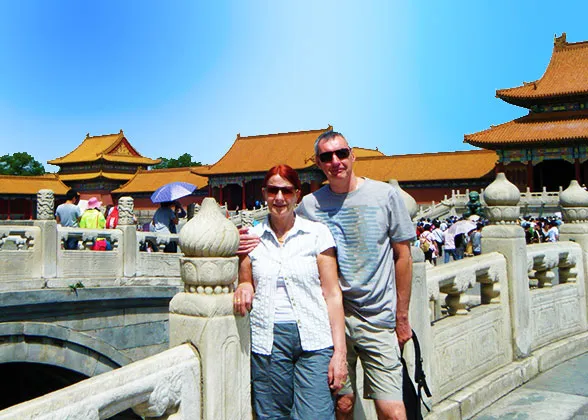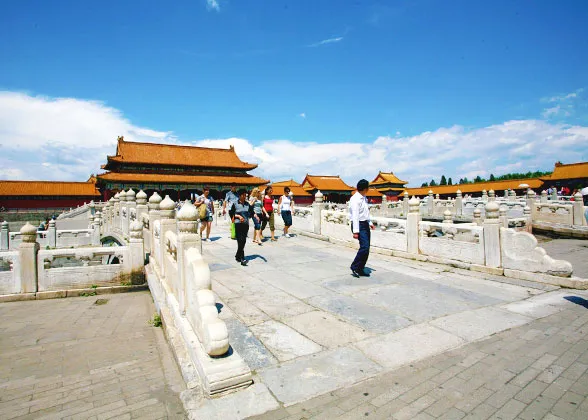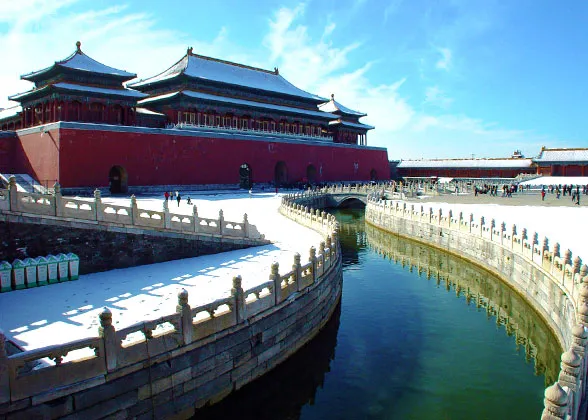Inner Golden Water Bridges (Neijinshuiqiao)
The Inner Golden Water Bridges, Neijinshuiqiao in Chinese, situated between the Meridian Gate and the Gate of Supreme Harmony, are the largest and most spectacular stone bridges within the Forbidden City. Named after the Inner Golden Water River flowing below, these bridges are exclusively used by the emperors and officials.
The Inner Golden Water Bridges feature five parallel single-arch bridges meticulously crafted from pristine white marble. The central bridge stands out as the longest, widest, and most exquisite, while the four bridges on the both sides gradually decrease in size and intricacy.
At the center, the majestic Imperial Bridge (Yuluqiao) stretches 23 meters (76 feet) long and 6 meters (20 feet) wide. Flanking it are the Noble Bridges (Wanggongqiao), each measuring 21 meters (70 feet) long and 5.5 meters (18 feet) wide. On either side of these are the Rank Bridges (Pinjiqiao), spanning 19.5 meters (64 feet) long and 4.9 meters (16 feet) wide.
The bridges are adorned with intricate stone railings, featuring torch-shaped balusters. The Imperial Bridge's balusters are carved with coiled dragons, while the Noble and the Rank Bridges depict lotus flowers.
From a bird eye view, the Golden Water River resembles a bow, with the bridges serving as five arrows nocked and ready to be launched.
The Inner Golden Water Bridges were initially built in 1417, originally consisting of three bridges. They were later expanded to five bridges in 1465. The structure we can see now, while having undergone repairs and renovations over the centuries, retains its original design and architecture from the 15th century.
The central Imperial Bridge was once a dedicated pathway solely for the emperor, designed with a gentle curvature to allow his sedan chair to pass smoothly.
The Noble Bridges, located on either side of the Imperial Bridge, were reserved exclusively for members of the imperial family and their closest associates.
Further out, the Rank Bridges welcomed high-ranking civil and military officials, those who held prestigious positions within the ancient Chinese governmental hierarchy, akin to the ministers and generals nowadays.
By examining who could use each bridge, we can see that the Inner Golden Water Bridges were not just mere pathways; they were symbols of the strict social and political hierarchy that once ruled China.
Each of the Golden Water Bridges represents one of the five ancient Chinese elements: metal, wood, water, fire, and earth, believed to regulate energy flow within the Forbidden City. They also embody the Five Virtues of Confucianism: benevolence, righteousness, propriety, wisdom, and trustworthiness, virtues rulers hoped to propagate.
The balustrade pillars of the Imperial Bridge feature coiled Chinese dragons entwined with auspicious cloud patterns, symbolizing the emperor's divine status as the Son of Heaven of extraordinary power, which is called "Zhen Long Tian Zi" in Chinese.
The balustrade pillar tops of the Noble Bridge and Rank Bridge are adorned with lotus petal patterns, symbolizing the integrity of officials, much like the lotus that rises untainted and straightly from the mud.
The Inner Golden Water Bridges, crafted predominantly in pristine white marble, symbolize the sanctity and inviolability of imperial power. As the final gateway for officials making their way to the emperor's audience, the white hue would evoke a sense of awe and reverence.
When standing in the middle archway of the Meridian Gate and looking north, the Gate of Supreme Harmony (Taihemen), flanked by the Zhaode and Zhendu Gates, comes into full view, all integrated well with the Inner Golden Water Bridges in front of them. This perspective offers an unparalleled view of the architectural harmony and symmetry that defines the Forbidden City.
For a more winding side river view, get close to either ends of the Inner Golden Bridges within the Taihemen Square. From here, you can see the Inner Golden Water Bridges with their graceful arches reflecting in the river in emerald green. The bridges, like jade rings half-submerged in water, add a touch of life to the otherwise quiet and solemn outer courtyard.
 Next
Next
Cross the Inner Golden Water Bridges and proceed northward into the Taihemen Square. Here, you will encounter the monumental Gate of Supreme Harmony (Taihemen). Beyond this gate lies the Outer Court, where you can explore the three iconic halls along the central axis:
Hall of Supreme Harmony (Taihedian)
Hall of Central Harmony (Zhonghedian)
Hall of Preserved Harmony (Baohedian)
If time permits, consider these highlights near Taihemen Square before advancing to the three halls:
East Side: Visit the Hall of Literary Glory (Wenhuadian), used for scholarly activities.
West Side: Explore the Hall of Martial Valor (Wuyingdian) and the Duanhong Bridge, notable for their architectural details and historical significance in military affairs.
What do the Inner Golden Water Bridges look like?
The Inner Golden Water Bridges feature five parallel single-arch bridges meticulously crafted from pristine white marble. The central bridge stands out as the longest, widest, and most exquisite, while the four bridges on the both sides gradually decrease in size and intricacy.
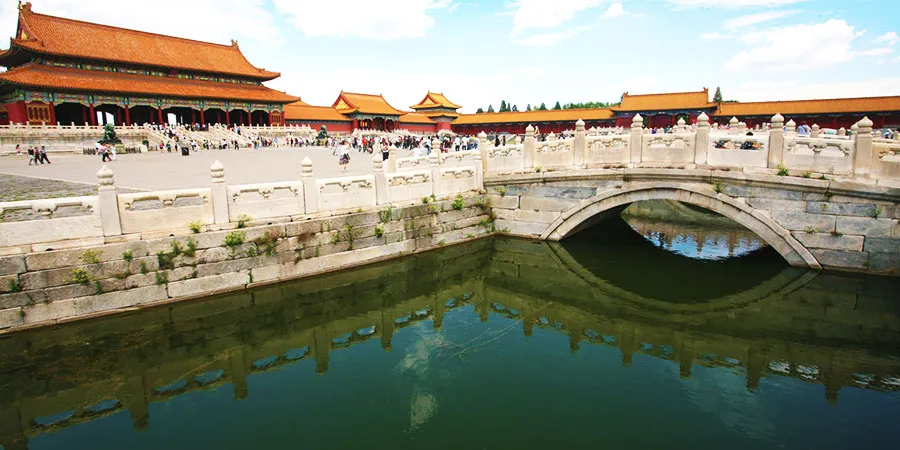 |
| Inner Golden Water Bridges & Gate of Supreme Harmony |
At the center, the majestic Imperial Bridge (Yuluqiao) stretches 23 meters (76 feet) long and 6 meters (20 feet) wide. Flanking it are the Noble Bridges (Wanggongqiao), each measuring 21 meters (70 feet) long and 5.5 meters (18 feet) wide. On either side of these are the Rank Bridges (Pinjiqiao), spanning 19.5 meters (64 feet) long and 4.9 meters (16 feet) wide.
The bridges are adorned with intricate stone railings, featuring torch-shaped balusters. The Imperial Bridge's balusters are carved with coiled dragons, while the Noble and the Rank Bridges depict lotus flowers.
From a bird eye view, the Golden Water River resembles a bow, with the bridges serving as five arrows nocked and ready to be launched.
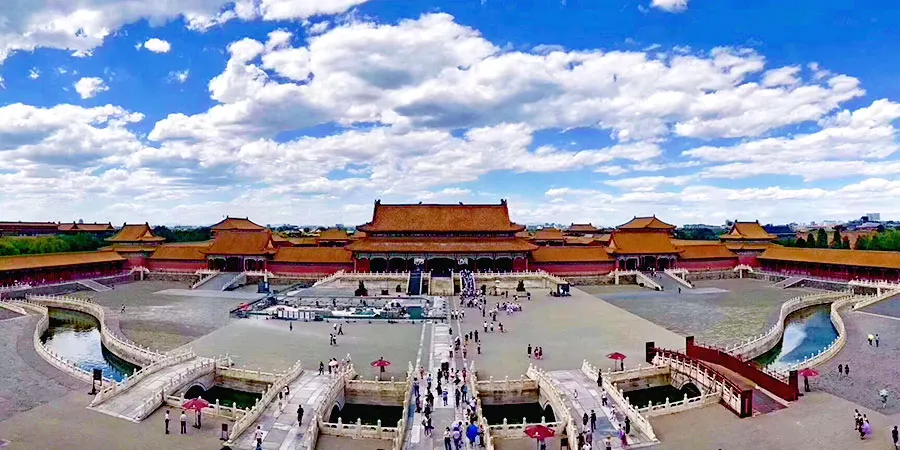 |
| Aeroview of the Inner Golden Water Bridges |
When were the Inner Golden Water Bridges built?
The Inner Golden Water Bridges were initially built in 1417, originally consisting of three bridges. They were later expanded to five bridges in 1465. The structure we can see now, while having undergone repairs and renovations over the centuries, retains its original design and architecture from the 15th century.
Who could use the Inner Golden Water Bridges?
The central Imperial Bridge was once a dedicated pathway solely for the emperor, designed with a gentle curvature to allow his sedan chair to pass smoothly.
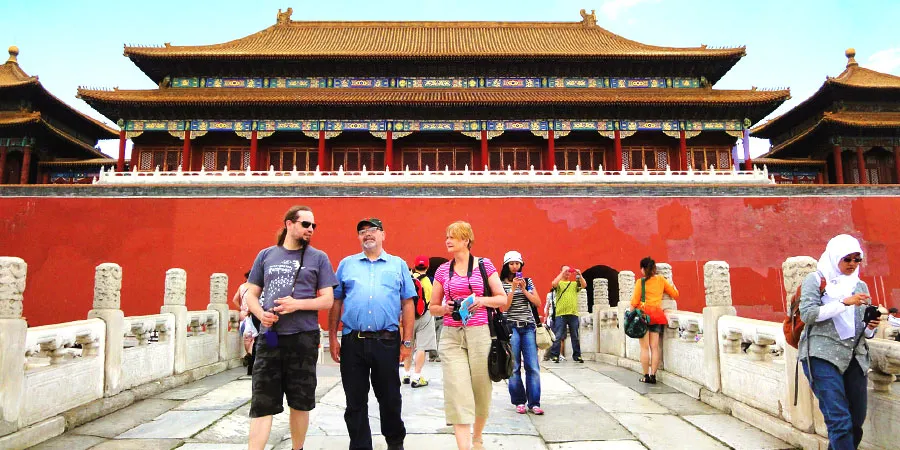 |
| Imperial Bridge |
The Noble Bridges, located on either side of the Imperial Bridge, were reserved exclusively for members of the imperial family and their closest associates.
|
|
Further out, the Rank Bridges welcomed high-ranking civil and military officials, those who held prestigious positions within the ancient Chinese governmental hierarchy, akin to the ministers and generals nowadays.
By examining who could use each bridge, we can see that the Inner Golden Water Bridges were not just mere pathways; they were symbols of the strict social and political hierarchy that once ruled China.
Symbolic Artistry of the Inner Golden Water Bridges
Five Bridges: Five Ancient Chinese Elements & Virtues
Each of the Golden Water Bridges represents one of the five ancient Chinese elements: metal, wood, water, fire, and earth, believed to regulate energy flow within the Forbidden City. They also embody the Five Virtues of Confucianism: benevolence, righteousness, propriety, wisdom, and trustworthiness, virtues rulers hoped to propagate.
Dragon amidst Cloud Carvings: Emperor's Divine Status & Supreme Power
The balustrade pillars of the Imperial Bridge feature coiled Chinese dragons entwined with auspicious cloud patterns, symbolizing the emperor's divine status as the Son of Heaven of extraordinary power, which is called "Zhen Long Tian Zi" in Chinese.
Lotus Carvings: Integrity
 |
| Lotus-patterned Carvings |
The balustrade pillar tops of the Noble Bridge and Rank Bridge are adorned with lotus petal patterns, symbolizing the integrity of officials, much like the lotus that rises untainted and straightly from the mud.
White Color: Imperial Sanctity
 |
The Inner Golden Water Bridges, crafted predominantly in pristine white marble, symbolize the sanctity and inviolability of imperial power. As the final gateway for officials making their way to the emperor's audience, the white hue would evoke a sense of awe and reverence.
Where is the best spot to admire the Inner Golden Water Bridges?
North of the Central Doorway of Meridian Gate (Wumen)
When standing in the middle archway of the Meridian Gate and looking north, the Gate of Supreme Harmony (Taihemen), flanked by the Zhaode and Zhendu Gates, comes into full view, all integrated well with the Inner Golden Water Bridges in front of them. This perspective offers an unparalleled view of the architectural harmony and symmetry that defines the Forbidden City.
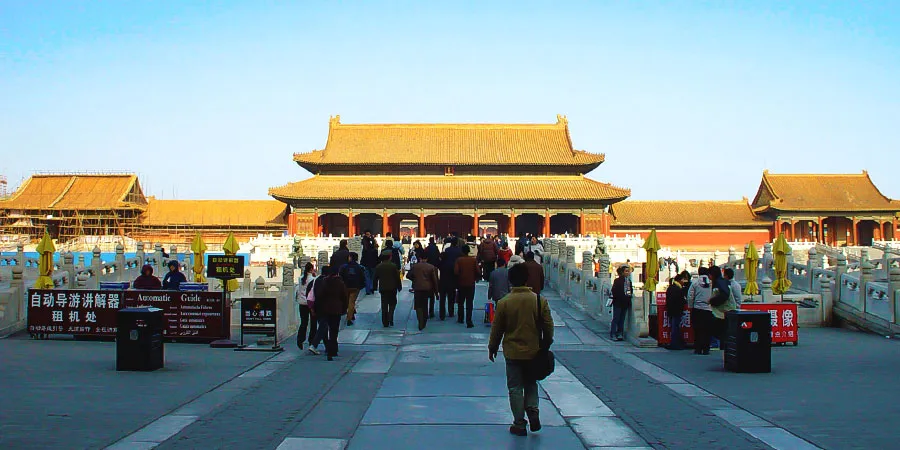 |
Ends of the Bridges on the Taihemen Square
For a more winding side river view, get close to either ends of the Inner Golden Bridges within the Taihemen Square. From here, you can see the Inner Golden Water Bridges with their graceful arches reflecting in the river in emerald green. The bridges, like jade rings half-submerged in water, add a touch of life to the otherwise quiet and solemn outer courtyard.
|
|
Cross the Inner Golden Water Bridges and proceed northward into the Taihemen Square. Here, you will encounter the monumental Gate of Supreme Harmony (Taihemen). Beyond this gate lies the Outer Court, where you can explore the three iconic halls along the central axis:
Hall of Supreme Harmony (Taihedian)
Hall of Central Harmony (Zhonghedian)
Hall of Preserved Harmony (Baohedian)
If time permits, consider these highlights near Taihemen Square before advancing to the three halls:
East Side: Visit the Hall of Literary Glory (Wenhuadian), used for scholarly activities.
West Side: Explore the Hall of Martial Valor (Wuyingdian) and the Duanhong Bridge, notable for their architectural details and historical significance in military affairs.
- Last updated on Apr. 15, 2025 by Jally Zhang -
